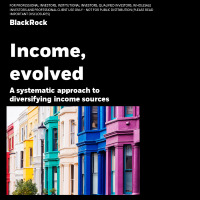Diversification and risk management cannot fully eliminate the risk of investment loss.
Overview
In a new regime of increased macro volatility, uncertain interest rates and stubborn sticky inflation, innovative alpha capture has the potential for adding resilience to portfolios. In this research, we explore the breadth of the systematic toolkit and offer an innovative approach to diversifying income sources that can help investors better navigate the challenges presented by today’s market regime.
Key points

Prioritizing downside mitigation

Dividend investing for income

A systematic approach for weathering uncertainty
Systematic income in a new regime
Income yielding assets went through a reboot in 2022, as global central banks stepped back from bond purchases and wound down long running policies supporting quantitative easing. The traditional 60/40 portfolio endured one of the worst calendar year performances on record in 2022, while the traditional role of fixed income (as a diversifier against equity market declines) came under scrutiny.3 Today, whilst sentiment in some of the world’s leading central banks has become more dovish, the proportion of global fixed income assets yielding greater than 4% has persisted at the elevated levels reached in 2023 (as shown in Figure 1). Higher yields mean income-oriented investors have more choice in seeking to generate income. However, higher correlations between bonds and equities, increased macro volatility, and questions around the overall strength of global economies has given investors a lot to consider when evaluating how to seek to generate consistent income for their portfolio.
Irrespective of the interest rate environment or market dynamics, not all income strategies are created equal. Headline market drivers in early 2024 were reminiscent of those in 2023. Resilient macro and micro data drove continued strength across global stocks, despite stubbornly sticky inflation data contributing to rates markets unwinding expectations for policy easing. Mega-cap technology stocks and AI leaders continued to drive gains, while interest rate-sensitive sectors lagged. As a result, investors who chose to hold their assets in cash or interest rate-sensitive securities missed out on substantial equity market returns.
Global stocks gained 11.30% in the first half of 2024 amid higher levels of macroeconomic volatility.4 US inflation data spiked bond yields, which later eased as economic activity cooled. In Europe, volatility rose due to a snap election in France. Additionally, a surprise hawkish move by the Bank of Japan in August caused global equity market turbulence as the Yen carry trade unwound.
What’s become apparent is that the current market regime likely holds more volatility, greater interest rate uncertainty, and pockets of sticky inflation. Despite the continuation of an elevated yield environment in 2024, ongoing market volatility highlights that innovative alpha capture opportunities may help add resilience in portfolios.
A diversifying source of income
Dividend-paying stocks can be an attractive option for investors seeking to deliver income in portfolios. During select decades (particularly when equity returns were under 10%), dividends have contributed over 50% of the total return of major indices.5 Figure 2 illustrates the contribution dividends have made over the last 12 months by region.
In addition to dividends providing a diversifying source of income and that may contribute to total return over longer time horizons, equity investing for income has three key benefits in our view:
- Dividends reflect earnings power
- Dividends may help mitigate potential losses from declines in equities
- Dividends may help return purchasing power to investors
While we believe dividend-paying stocks can be riskier than bonds, a focus on high quality dividend yielding stocks may dampen equity market volatility, offers investors a way to maintain equity exposure to capture potential price appreciation, and aims to deliver reoccurring income to investors. Despite these attractive qualities, pursuing high-yielding stocks alone can generate portfolios with higher exposure to certain sectors (as shown in Figure 3) and style factors, including value.
Banking, consumer staples, and utilities stocks are typically well represented in equity dividend strategies, but also tend to be established companies that offer lower growth potential. Consequently, traditional equity dividend portfolios typically exhibit an inherent value bias. In addition, dividend yields for major indices like the S&P 500 Index have fallen considerably to 1.3% as of August 30, 2024 (relative to over 6% at peaks in the early 1980s), which may be lower than the income levels required by some investors.6 These dynamics have been a headwind for equity income strategies, and traditional dividend yield strategies largely fell out of favor with investors, until recently. However, an equity dividend solution could be more appealing and diversifying to client portfolios. This solution targets a higher yield and lower risk, without the value footprint of a traditional equity income strategy.
Systematic tools help reduce style bias
As the Covid-19 pandemic hit in 2020, many companies across the world postponed, canceled or reduced their dividends. In the MSCI ACWI Index, 279 stocks cancelled their dividend all together.7 Plummeting yields, growth stock dominance, and dividend companies suspending or reducing payments left equity focused income investors confronted with a triple threat in their portfolios. Traditional financial information gave little guidance to assess future payout ratios, debt levels and dividend growth in a pandemic driven market. But what if investors employed a “real time” modernized approach to navigating the challenges faced by investors?
Through this systematic lens, we believe we can devise better ways to anticipate, and potentially capture – or harvest – dividends. Using a dividend rotation strategy that forecasts payment dates to more efficiently allocate capital to firms with variable dividend opportunities when more yield may be available, we can build a portfolio that is more diversified and has less of a style tilt to value companies than the typical equity dividend strategy. Our overall philosophy for managing a portfolio of stocks with a higher-than-average dividend yield is based on the hypothesis 8 that if three stocks each have a 1% yield and pay their dividend at different times of the year, we can theoretically source 3% income annually at the portfolio level. This strategy offers a greater range of flexibility in its composition and is not constrained to a “buy and hold” approach to dividend yielding companies.
Dividend payment dates range widely across countries. In Canada, Ireland, or the US, its more common to have quarterly dividend payments, while countries such as Australia, Japan, Korea, or the UK tend to have semi-annual dividend payments. In continental Europe, many countries issue annual dividend payments, making a traditional buy-and-hold strategy less effective than one that could dynamically overweight positions prior to payout. For example, the largest company in the Swiss stock exchange is Nestlé, the world’s largest food and beverage company.9 Nestlé usually pays its annual dividend each April, following shareholder approval at its Annual General Meeting. A systematic approach offers the opportunity to screen thousands of securities based on dividend growth, profitability, and other metrics to help investors time their exposure to these payments to deliver income and potential alpha. Figure 4 shows in practice how this rotation strategy can be scaled to take advantage of the seasonality of dividend payments across countries, with European companies tending to focus payments in March-May, Taiwanese companies in July and August, and Japanese companies making two payments in March and September.
Monthly dividend yield breakdown by country
Harvesting dividends and rotating into other stock specific opportunities could have helped income investors generate positive total returns during 2019’s growth market. Simultaneously, a rotation strategy would likely have outperformed a traditional dividend strategy during 2020, when “stay at home” growth stocks (stocks that benefitted from accelerated use of their services during the pandemic) surged, and traditional funds were forced to buy and hold dividend stocks that lagged the market. Conversely, this approach may trail the performance of a typical dividend strategy characterized by a value or quality tilt when those styles are in favor, for example in 2022. We believe a systematic approach to income investing makes it possible to achieve greater diversification across income sources, while also reducing risk and increasing yield at the portfolio level.10
Two sources of income can help combat sticky inflation and interest rate uncertainty
Strategies seeking dividend-paying companies, that combine healthy balance sheets with solid yields, generally may help bolster whole portfolio resilience. But as uncertainty lingers around interest rates staying higher for longer and market volatility remains elevated, there is a continued need to evolve income strategies in order to seek to deliver positive inflation-adjusted returns, irrespective of market environment. Using call overwriting in combination with delta hedging may potentially help reduce directional risk, aiming to generate additional income and assist with the management of overall portfolio risk in times of higher market volatility.
Income optionality
A call option11 is one of the most basic forms of options contracts, and gives the buyer the right, but not the obligation, to buy shares of a stock at a specified price, up to a defined expiration date. A call option buyer profits when the underlying asset price increases (beyond the total of the specified price and cost of the option) and the buyer exercises the option to buy as markets go up. A call option can also be implemented using exchange traded (listed) index options to mitigate counterparty risk in aiming to generate additional income and help reduce stock specific idiosyncratic volatility. In essence, selling call options can provide a tool that may help investors incrementally enhance yield.
To offset this risk of potential upside getting “called away,” investors can purchase index futures contracts to “delta hedge,” 12or reduce the directional risk associated with the overwriting strategy (selling covered call options on a long equity position). The delta hedge ensures an overwriting strategy doesn’t sell away too much upside (as buyers exercise the option if markets go up). Exchange traded futures contracts seek to allows investors to hedge the market risk associated with the potential direction of a security or financial instrument. As an illustrative example, Figure 5 shows how these two return sources can be used in tandem. A strategy employing these tools in a diversified portfolio with hundreds of companies could typically have a handful of covered call options contracts and four futures contracts that are continually priced and exchange traded. In this way, an enhanced income strategy may boost income using two sources of income and target specific amounts to precisely hit a desired income level per year.
Delivering income systematically
A desirable outcome for most income-focused investors is the ability to generate higher levels of income, at lower levels of risk, with enhanced diversification characteristics. As systematic investors, we believe there is a fourth piece to this puzzle: the ability to deliver these targeted levels of income more consistently over time. Traditionally equity income strategies rely on buy-and-hold approaches that target higher-yielding equities to generate income. We believe today’s market dynamics require an approach that is more agile. Leveraging cutting edge technology can help identify shifts in dividend payment frequencies across both industries and countries. In addition, incorporating the use of an options premium from call options, written on indices rather than single stocks, can complement positioning in high income opportunities. Using this model, systematic investors can exchange potential market upside for a secured premium and help preserve high conviction stock selection views. This evolved approach to income investing seeks to provide investors with a systematic approach to targeting diversifying income sources more consistently.13



